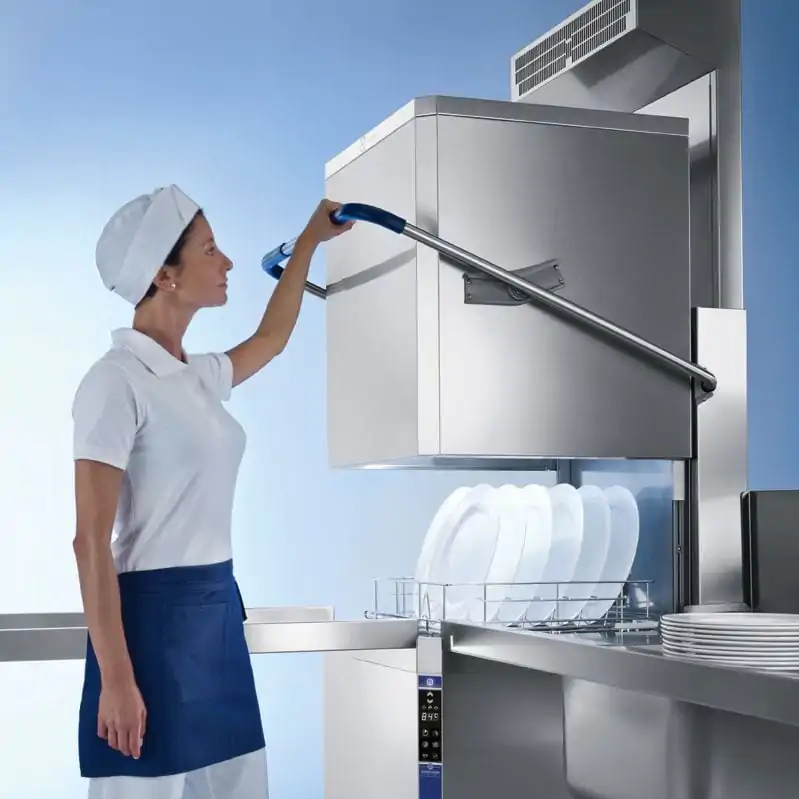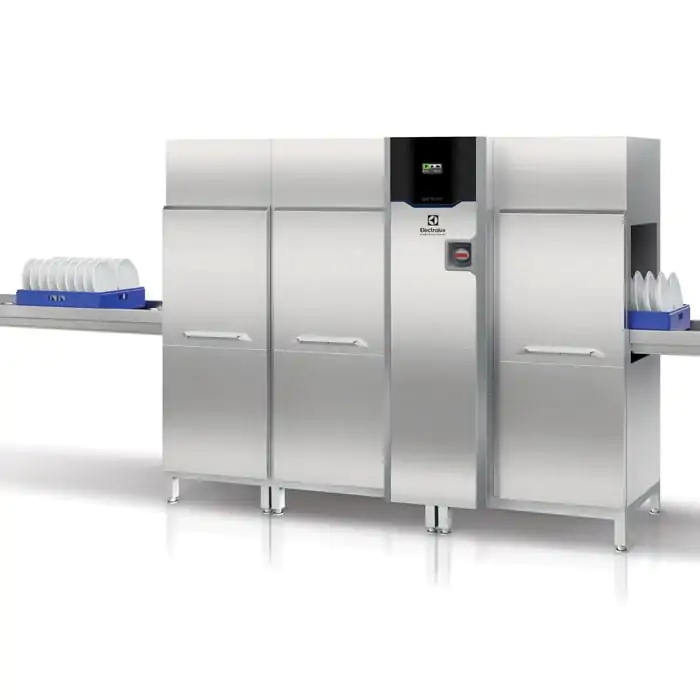Having access to sparkling glassware, spotless plates and polished cutlery is vital to the smooth running of any food service outlet, which makes investing in the right commercial dishwasher incredibly important.
With so much to bear in mind, choosing the best piece of kit for your operation is not always easy. To help you decide, our guide will take you through everything you need to know about choosing, using and maintaining a commercial dishwasher.
How clean customers perceive tableware to be can have a huge effect on their eating experience, as it provides an early indication of a venue’s attention to detail as well as its attitude towards hygiene. A survey by Consumer Reports in the US found that for 76% of restaurant-goers, their top complaint was ‘dirty utensils or table’.
But performance isn’t the only factor in deciding which commercial dishwasher to buy. Machines are often switched on early in the morning and turned off late at night, so other considerations such as reliability and efficiency are also critical to remaining both productive and profitable throughout the day.
How to choose a commercial dishwasher
There are a variety of things to consider when it comes to making any investment in dishwashing equipment. These fall under the following categories – each of which will have a major impact on how effective and efficient the machine will be:
Type: The first thing to think about is the kind of model that best suits your needs. Undercounter dishwashers can be great for smaller restaurants or bars that are short on space, whereas abovecounter variants deliver higher productivity for larger operations. Medium-sized restaurants and hotels should opt for a Hood Type model, whilst Rack Type options are better for those with particularly demanding requirements – such as contract caterers, universities and stadiums.
Capacity: Make sure any model you choose is the correct size for the number of items it will have to wash. Also consider the size and shape of your tableware, as that will affect which model is best for your needs. Our commercial dishwashing range goes from 30 racks per hour for undercounter models, to Rack Type dishwashers able to process 300 racks per hour.
Speed: Different models operate at different speeds, so it’s worth keeping track of how many dishes are used during the average day and how many items are likely to need washing per hour.
Tabling: It’s really important to think of warewashing as a system, rather than just an individual machine. Factor in enough inlet and outlet tabling so that items can be rinsed, cleaned and dried without obstructing the flow of tableware.
Accessories: Think about how many racks or baskets you’ll need to keep things moving. Contrary to popular belief, dishwashing racks are not universal, so it’s best to have a variety of sizes to choose from depending on what’s being processed.
How to use a commercial dishwasher
Once you have chosen the perfect dishwasher (or dishwashers), it’s time to get to work. While a new piece of equipment can be intimidating for operators, most of the latest machines are designed to be as easy to use as possible.
Even so, there are a few simple things to bear in mind which will ensure you’re getting the most from your investment, and protecting it for the long term.
Learn the process – Each dishwasher tends to have two pipes: one for detergent and another for rinse aid. All operators need to do is put the weights supplied on the end of the pipe, and then place the pipe into the relevant container of chemicals.
Swapping containers is as easy as taking the lid off the new bottle, removing the pipes from the old bottle and placing them into the new one. Models with a dedicated de-lime cycle may have an additional pump and pipe. This simply requires the addition of a bottle of white vinegar.
Use the correct accessories – The next step is to load the dishwasher correctly. Glasses, cutlery and crockery come in all different shapes and sizes, so the person operating the dishwasher will need to choose the right baskets to do the job. As discussed above, it’s important to have a variety to hand, as well as to leave enough space for pre-rinsing and stacking items before they go into the machine.
Choose the right cycle – We all know that a dishwasher will generally come with a number of programmes – but how often do you choose a different one depending on what’s being washed? Each cycle is designed for a specific purpose, so using the full range of options will ensure the best results every time:
Shorter cycles are designed for items that are predominantly clean
Longer cycles are for items that are very dirty, or where the plates have been left for a while and food has dried on.
Keep it clean – For plates, glasses and cutlery to look great and remain hygienically clean, it’s vital that both the water you wash with, and the machine itself, are kept as clean as possible. The first step to this is proper filtration. Not only will clean water ensure items are washed hygienically, but clean water will also help to minimise the amount of detergent, water and energy needed, providing double the benefit for budget-conscious businesses!
The second step to a clean machine is to consider the type of water you will be washing in. Hard water is supplied to around 60% of the UK, and can have a noticeable effect on the performance and longevity of a dishwasher – not to mention the cumulative cost of fixing equipment and replacing watermarked plates or glasses. There are two main features to look out for in modern dishwashers which can tackle the effects of hard water:
A water softener treats the water either before or as it enters the machine. This will prevent the build-up of scale on the machine’s internal components and help to extend the life cycle of the dishwasher.
A de-lime cycle rids the heating elements of scale, which ensures a dishwasher will continue to reach the high temperatures needed for effective cleaning.
How to look after your commercial dishwasher
The savviest investors know that the machine itself is only half the story. A broken dishwasher can pose a huge logistical problem, both in terms of ensuring customers have tableware to eat from, and maintaining the high hygiene standards needed. So what measures can a business put in place to keep its kitchen running smoothly?
Maintenance
It’s not uncommon for businesses to use a dishwasher until it breaks, and then get it serviced. It goes without saying that you wouldn’t do this with a car, so why do it with a dishwasher?
Identifying potential problems early on is key to avoiding them, so regular maintenance will keep the machine working better for longer – and with fewer breakdowns. This will contribute to reducing the lifetime cost of your equipment, so it’s well worth backing up your investment by opting for a service contract with planned preventative maintenance (PPM) visits each year.
Warranties
Dishwasher warranties are a clear display of the manufacturer’s faith in their equipment, so they should also come under the scrutiny of potential investors. Most food service operations would struggle to go even a day without a dishwasher, so as well as checking the length of the agreement and what it covers, consider any additional back-up services offered by the manufacturer. These can even include preventative maintenance checks, which will avoid potential downtime and extend the lifespan of equipment.
Repair services
As with any machine, dishwashers can occasionally go wrong. However, the last thing any business want is to be put out of action by a broken piece of equipment. To help keep your kitchen running in a worst-case scenario, there are a questions you can ask before investing. Is your dishwasher from a reputable manufacturer? Are spare parts readily available? Can you get access to replacement machine, quickly?
Our Electrolux Professional Express range is made up of a selection of the most commonly replaced dishwashing and glasswashing equipment. That means if a dishwasher were to break down, businesses can get hold of a replacement the very next day – with flexible finance options also available for those who don’t have the necessary capital to replace kit straight away.
Training
Product training is the best way of getting the most from any piece of commercial kitchen equipment, as well as keeping it running correctly. We offer comprehensive training both on-site, and at our Center of Excellence in Luton. For more hints and tips, you can also check out our Chef Hacks.
Any investment in commercial kitchen equipment represents a significant commitment, but with dishwashers often in operation all day, every day, the question of which to choose for your business is even more pivotal. For those who get the decision right however, the result is a machine that will deliver sparkling performance – and tidy returns – time and again.

